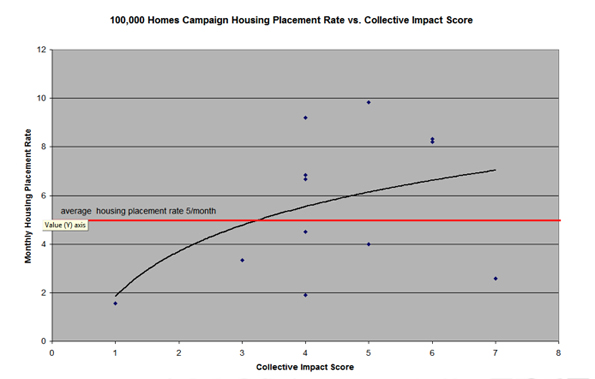Earlier this year, a colleague handed me the Stanford Social Innovation Review article “Collective Impact.” Intuitively, I knew that the basic premise—that large-scale change requires broad cross-sector coordination—was true from my work on Community Solutions’ 100,000 Homes Campaign; however, thanks to a recent survey that we conducted with the National Alliance to End Homelessness, we now have some preliminary data to support it further.
With 100,000 Homes, any organization can enroll its community in the campaign, as long as it is committed to the shared aim of finding and housing the most vulnerable homeless people in their community. We recruit and work closely with leaders from all four sectors—nonprofits, local government, business, and philanthropy.
We have been curious, though, about the extent to which having representation on the local 100,000 Homes Campaign impacts the results that the team is able to achieve. Recently, our partners at the National Alliance to End Homelessness worked with us to create a survey of 100,000 Homes Campaign teams. We wanted to find out which sector led each local team and which sectors comprised them, as well as the extent to which they worked effectively with local Veterans Affairs offices and local public housing authorities (two tremendous sources of housing supply).
Nineteen out of ninety-five communities (20 percent) responded to the survey. We screened out communities that had not yet completed their “Registry Week”, in which volunteers canvass the streets for three mornings to create a by-name list of everyone experiencing homelessness and to administer a survey (called the Vulnerability Index) to determine the fragility of their health.
Are you enjoying this article? Read more like this, plus SSIR's full archive of content, when you subscribe.
Of the remaining twelve communities, we created a “collective impact score,” which gives one point for each of the following sectors represented on their campaign leadership team: Veterans Administration, public housing authority, local government, Continuum of Care (a coordinating body for federal homeless grant applications), Business Improvement District, nonprofits, and philanthropists. A total of 7 points is possible on the collective impact score. We weighted it to allow additional points for inclusion of the Veterans Administration and public housing authority, because we believe that their participation is critical to large-scale systems change in solving chronic homelessness. We then compared the collective impact score to the communities’ monthly housing placement rate—that is, the average number of vulnerable people they move into permanent housing each month.
The chart below demonstrates a modest positive correlation between the collective impact score and the community’s housing placement rate.

Note that no communities with a collective impact score below 4 had a placement rate above the average of 5 vulnerable people per month; however, there were two outlier communities with more than 4 sectors on their local campaign team that were under-achieving in terms of housing placement and impact. One of those communities is early in their involvement in the 100,000 Homes Campaign and currently in the process of significant community dialogue toward an even deeper collective impact approach. The other community is struggling with securing full alignment with their nonprofit partners. Clearly there are factors beyond simply having the right sectors at the table for creating significant impact in ending homelessness; however, this early look at the data indicates that if a community wants to have the best chance at truly achieving something breathtaking, getting the right sectors to the table and actively engaged is a great place to start.
Support SSIR’s coverage of cross-sector solutions to global challenges.
Help us further the reach of innovative ideas. Donate today.
Read more stories by Becky Kanis.

